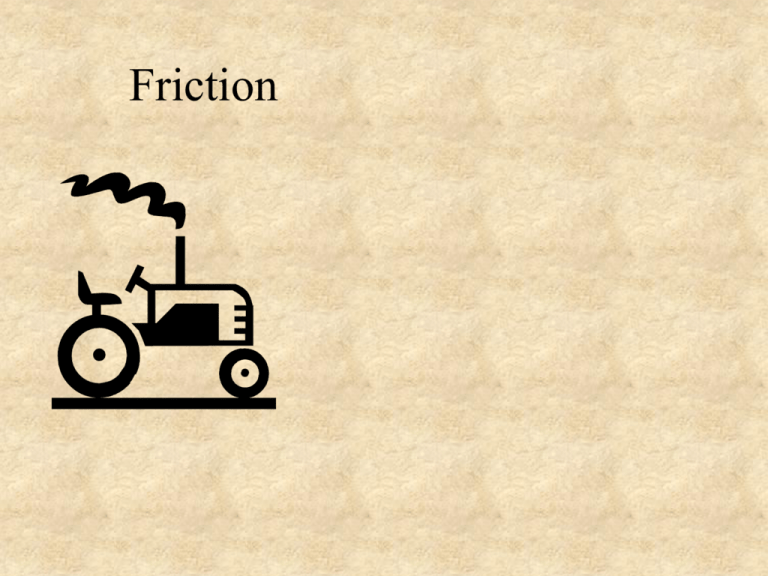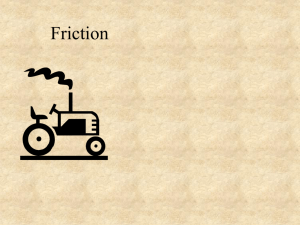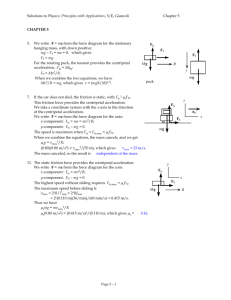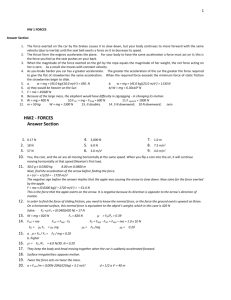05-01Friction
advertisement

Friction Friction - the force needed to drag one object across another. (at a constant velocity) Depends on: •How hard the surfaces are held together (demo) •What type of surface it is (I.e. rough, smooth) Not supposed to depend on: •Surface area (pressure) •Speed (low speeds) (demo) Ff = FN = mg Force of Friction in N Coefficient of Friction. 0<<1 (Specific to a surface) - in your book) Normal Force - Force exerted by a surface to maintain its integrity Usually the weight (level surfaces) These are approximate What’s up with the two columns? How are they related (one bigger) Kinetic Friction - Force needed to keep it going at a constant velocity. Ff = kFn Always in opposition to velocity (Demo, example calculation) Static Friction - Force needed to start motion. Ff < sFn Keeps the object from moving if it can. Only relevant when object is stationary. Always in opposition to applied force. Calculated value is a maximum (Demo, example calculation, examples of less than maximum) Concept 0 – finding the force of friction: (not on noteguide) Ff = μFN = μmg (g = 9.8 N/kg) 1. What is the force of friction between a 3.40 kg mass and the counter if the coefficient of friction is 0.140? 2. What is the force of friction between a 4.00 kg mass and the floor if the coefficient of friction is 0.350? 3. What is the mass if it takes 23.0 N to drag block across the floor where the coefficient of friction is 0.293? 4. What is the coefficient of friction if it takes 4.80 N to drag an 823 g (0.823 kg) mass across the counter? 1) 4.66 N 2) 13.7 N 3) 8.01 kg 4) 0.595 A 5.00 kg block rests on a level table where there is a static coefficient of friction of 0.470, and a dynamic of 0.170. a) What are the dynamic and maximum static forces of friction? b) if it is at rest and you exert a force of 12.0 N sideways on it what happens? c) if it is at rest and you exert a force of 35.0 N to the right on it, what is the acceleration of the block? d) If it is sliding to the right and you exert a force of 7.50 N to the left, what is the acceleration of the block? e) If it is sliding to the right, but decelerating at 0.950 m/s/s, what force is acting on the block? f) If it is sliding to the left, but decelerating at 1.20 m/s/s, what force besides friction must be acting on the block? a) 23.0 N, 8.33 N; b) Nada; c) 5.33 m/s/s; d) -3.17 m/s/s, e) +3.58 N, f) -2.33 N Whiteboards: Friction a-k A 6.00 kg block rests on a level counter where the static coefficient of friction is 0.620, and the dynamic is 0.310. a) Calculate the dynamic and maximum static friction between the block and the counter. (Store these in your calculator for later use) 6.00 kg 36.456 ≈ 36.5 N, 18.228 ≈ 18.2 N W m = 6.00 kg, μs = 0.620, μd = 0.310 (36.456 18.228) b) if the block is initially at rest, and you exert a force of 30.0 N to the right, does the block move? Draw a force diagram with four arrows – weight, R, applied force, and static friction force. Use longer arrows for bigger forces, indicate congruencies. R = 58.9 N Static Friction (-30.0 N) 6.00 kg Applied (30.0 N) Weight = -58.9 N yup yup nothin to see here m = 6.00 kg, μs = 0.620, μd = 0.310 (36.456 18.228) c) Suppose the block is sliding to the right, and there is a force of 25.0 N to the right, what is the acceleration of the block? 6.00 kg +1.13 m/s/s W m = 6.00 kg, μs = 0.620, μd = 0.310 (36.456 18.228) d) If the block is sliding to the right, and there is a force of 12.0 N to the left, what is the acceleration of the block? 6.00 kg -5.04 m/s/s W m = 6.00 kg, μs = 0.620, μd = 0.310 (36.456 18.228) e) If the block is sliding to the left and there is a force of 45.0 N to the right, what is the acceleration? 6.00 kg +10.5 m/s/s W m = 6.00 kg, μs = 0.620, μd = 0.310 (36.456 18.228) f) What applied force would make the block slide to the right and accelerate to the right at 5.60 m/s/s? 6.00 kg +51.8 N W m = 6.00 kg, μs = 0.620, μd = 0.310 (36.456 18.228) g) What force is being applied to the block if it is sliding to the right but decelerating at 2.40 m/s/s? 6.00 kg +3.83 N W m = 6.00 kg, μs = 0.620, μd = 0.310 (36.456 18.228) h) What force is being applied to the block if it is sliding to the left, but decelerating at 5.20 m/s/s? 6.00 kg +13.0 N W m = 6.00 kg, μs = 0.620, μd = 0.310 (36.456 18.228) i) Suppose the block is sliding freely to the right at 8.90 m/s. In what time will the block be brought to a halt? 6.00 kg 2.93 s W m = 6.00 kg, μs = 0.620, μd = 0.310 (36.456 18.228) j) If the block begins to slide to the right, and there is a force of 42.0 N acting to the right, what is the displacement of the block when it reaches a speed of 15.0 m/s? 6.00 kg +28.4 m W m = 6.00 kg, μs = 0.620, μd = 0.310 (36.456 18.228) k) If the block is sliding to the right at 9.00 m/s, and is brought to a halt in a distance of 18.0 m, what force besides friction acted horizontally as it was stopping? 6.00 kg +4.75 N W What is the force needed to drag a 12 kg chunk of rubber at a constant velocity across dry concrete? F = ma, FFr = kFN FN = weight = mg = (12 kg)(9.8 N/kg) = 117.6 N FFr = kFN = (.8)(117.6 N) = 94.08 N = 90 N 90 N W What is the force needed to start a 150 kg cart sliding across wet concrete from rest if the wheels are locked up? F = ma, FFr < sFN FN = weight = mg = (150 kg)(9.8 N/kg) = 1470 N FFr = kFN = (.7)(1470) = 1029 N = 1000 N 1000 N W s = .62, k = .48 What is the acceleration if there is a force of 72 N in the direction an 8.5 kg block is already sliding? v FFr 72 N 8.5 kg FFr = kFN, FN = mg, FFr = kmg FFr = (.48)(8.5 kg)(9.8 N/kg) = 39.984 N F = ma <72 N - 39.984 N> = (8.5 kg)a, a = 3.77 = 3.8 ms-2 3.8 m/s/s W s = .62, k = .48 What unknown force makes an 8.5 kg block slide and accelerate to the right at 6.2 m/s/s? v FFr F=? 8.5 kg FFr = kFN, FN = mg, FFr = kmg FFr = (.48)(8.5 kg)(9.8 N/kg) = 39.984 N F = ma <F - 39.984 N> = (8.5 kg)(6.2 m/s/s), F = 92.684 N 93 N W s = .62, k = .48 A 22 kg block is sliding on a level surface initially at 12 m/s. What time to stop? v=12m/s FFr 22 kg FFr = kFN, FN = mg, FFr = kmg FFr = (.48)(22 kg)(9.8 N/kg) = 103.488 N F = ma < -103.488 N> = (22 kg)a, a = -4.704 ms-2 vf = vi + at, vf = 0, vi = 12, a = -4.704 ms-2, t = 2.55 s = 2.6 s 2.6 s W s = .62, k = .48 A 22 kg block is sliding on a level surface initially at 12 m/s stops in 2.1 seconds. What external force is acting on it besides friction?? v=12m/s FFr F=? 22 kg v = u + at, v = 0, u = 12 m/s, t = 2.1 s, a = -5.7143 ms-2 FFr = kFN, FN = mg, FFr = kmg FFr = (.48)(22 kg)(9.8 N/kg) = 103.488 N F = ma < -103.488 N + F> = (22 kg)(-5.7143 ms-2), F = -22 N (left) -22 N (to the left) W s = .62, k = .48 A 13.2 N (its weight) box accelerates and moves to the right at 3.2 m/s/s, what force must be applied? v FFr a = 3.2 ms-2 F=? 13.2 N FFr = kFN, FN = 13.2 N FFr = (.48)(13.2 N) = 6.336 N wt = mg, m = wt/g = (13.2 N)/(9.8 N/kg) = 1.3469 kg F = ma < F - 6.336 N> = (1.3469 kg)(3.2 ms-2), F = 10.646 = 11 N 11 N W s = .62, k = .48 A force of 35 N in the direction of motion accelerates a block at 1.2 m/s/s in the same direction What is the mass of the block? v FFr m a = 1.2 ms-2 35 N FFr = kFN, FN = mg, FFr = kmg FFr = (.48)m(9.8 ms-2) = m(4.704 ms-2) F = ma < 35 N - m(4.704 ms-2) > = m(1.2 ms-2) 35 N = m(4.704 ms-2) + m(1.2 ms-2) = m(4.704 ms-2 + 1.2 ms-2) m = (35 N)/(5.904 ms-2) = 5.928 kg = 5.9 kg 5.9 kg W




